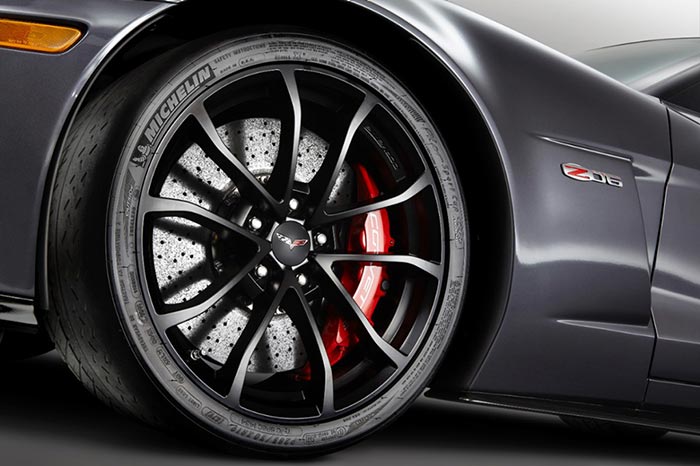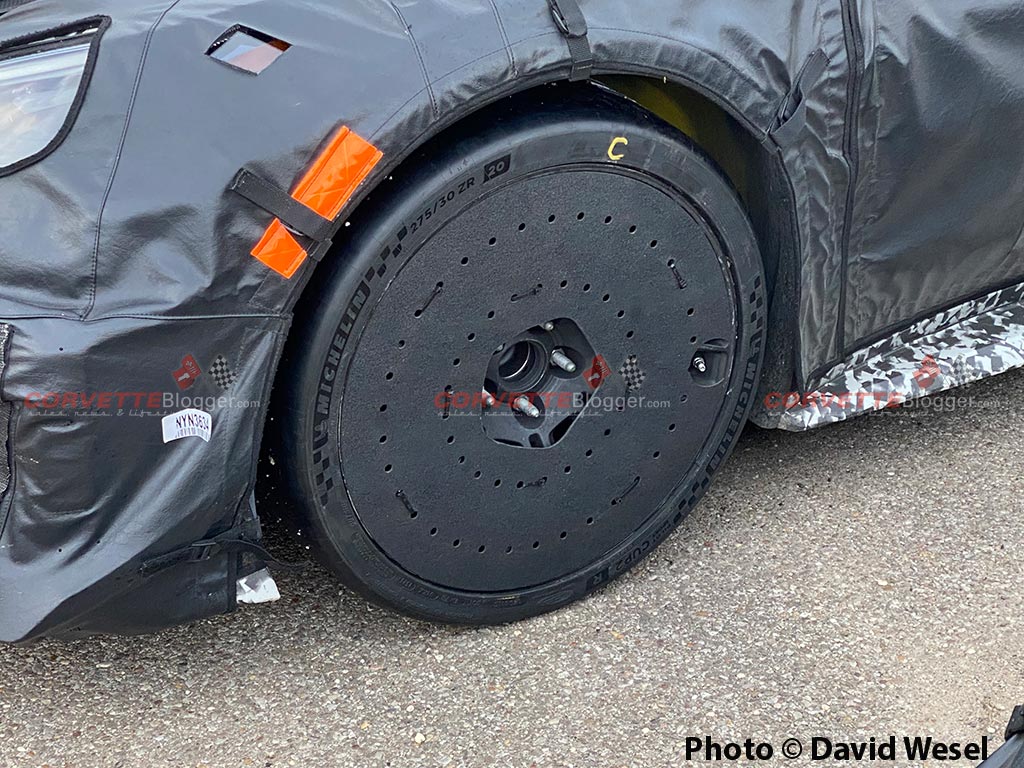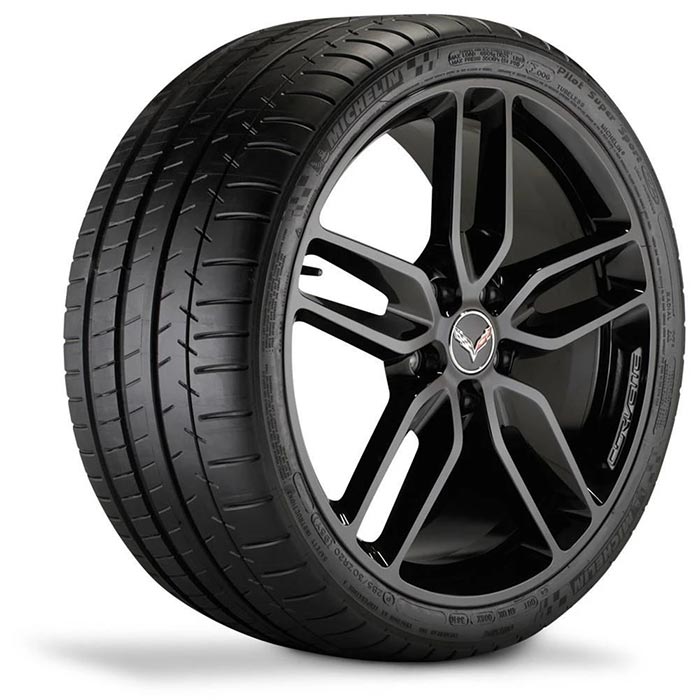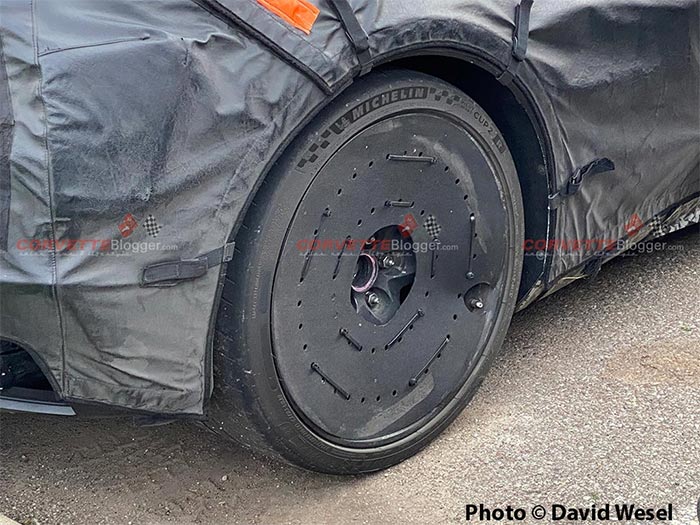Like celebrities claiming to have seen UFOs lately, Corvette fans across this great nation have been spotting camouflaged C8 mules with amazing frequency lately! One of the most interesting and educational sightings thus far came about a month ago in the Buckeye State. These pictures gave the official nerds here at CorvetteBlogger a lot of info to unpack and we mostly (and rightly) focused on the varying exhaust placements of the cladded C8s, but the up-close shots of the tires deserve their own deep dive! The Michelin script in the picture of the rear tire reads; 345/25 ZR 21. Even for many people who are passionate about their cars, that alphanumeric mess is nothing but a load of gibberish. If you are interested in becoming a master of decoding your Corvette’s sidewalls, you are in the right place! Join us below!
Part I: What does it all mean, Basil?
Let’s start by translating the C8 Z06 spy photos from Michelin to English, shall we? From right to left, here is what each character and numeral stands for:
21=Wheel size, in inches
The Corvette’s factory rims are about to eclipse those of early ’00s music video Escalades!
R=Radial tires
Compared to old-fashioned bias-ply tires, radials provide a longer service life, offer better ride and handling characteristics, and lower rolling resistance. These improvements lead to better returns in grip and fuel economy.
Fun facts: The original US patent for a vehicular tire with the cord plies running perpendicular to the direction of travel was filed by tire maker and firearm designer Arthur W. Savage all the way back in 1916, though he was beaten to the punch by a pair of inventors who filed in London more than a year prior. Neither patent spawned a prototype.
It wasn’t until 1946 that French tire company, Michelin, started commercializing radial-ply rubber, independent of any previous work.
Radials didn’t become standard equipment on an American vehicle until 1970 when Ford began shipping the Lincoln Continental Mark III with an updated set of those 1946 Michelins. Just twelve years later, radials were factory-installed on every single US-built automobile. Talk about market penetration!
Z=The tire’s speed rating
Prior to 1990, manufacturers used a Z-rating to let everyone know that their tires were certified for use on cars capable of traveling in excess of 149 MPH. Even though it is still stamped into the side of modern performance rubber, the development of ever-faster vehicles led to the creation of a three-plus-tiered redefinition of the original Z-rating. These days, the action starts with a “V-rating” that is certified up to the old benchmark of 149 MPH. The “W-rating” picks up where V left off and covers the ground leading up to its max speed of 168 MPH. Next comes the 186 MPH (300 KPH) Y-rating and, finally, a (Y) rating that covers everything over 186 MPH. Unsurprisingly, the Michelins in the C8 Z06 spy photo show a Y in parenthesis in the fine print below the main script.
25=The aspect ratio
i.e., how tall the sidewall is compared to a tire’s width (the bigger the number, the more rubber you’ll see when looking at a vehicle from the side; low-pros=small aspect ratio, off-road meats=high aspect ratio). The new Z06 apparently runs a tire that has a height equal to 25% of its width, which brings us to…
345=Tire width
We decoded the tire in reverse order so that we could conclude with the most pertinent information; the tire’s width in millimeters. If the car in the picture is, in fact, the C8 Z06, the mid-engine Corvette will be making its first foray into full-on supercar territory wearing absolutely massive tires! 345 mm equates to 13.5827 inches, giving the Z’s driven wheels a 27.1654-inch-wide contact patch!
Part II: Perspective

With 345s at both rear corners, the C8Z is about to be Corvette with the most rubber touching the ground in the model’s history!
How we got here, an account of Z06 tires through the years:
RPO Z06 first materialized out of the mind of Zora Arkus-Duntov in 1963 as a package that would beef up his second-generation Corvette for road course use. Just 199 of them were produced before being dropped from order sheets for 1964. The entire run sat on 15-inch wheels wrapped in 170 mm wide tires. That is just 6.69 inches of bias-ply rubber touching the pavement on each driven wheel!
The Z06 as we currently know it debuted in 2001, and it became the first of its kind to wear radial tires in a staggered set-up. Out front was a pair of 265s on 17-inch rims, and out back, on 18s were 295-mm wide tires. That means that a C5Z can leave a pair of 11.6-inch black stripes on any stretch of road with an overzealous driver at the helm! If you are curious, the tires on the C5 Z06 were actually narrower than the ones on the C4 ZR-1. The King of the Hill wore a front set of 275s with 315s (12.4 inches) in the rear.
After a one-year sabbatical, the Z06 returned for 2006, and it did so with a new 7.0L version of the Gen IV small-block V8 that sent 505 rampaging horses to the ground through a pair of 325 mm (12.795 inches) Goodyears in base form. In 2011, the Z07 package debuted with a new rolling arrangement that added 10 mm of width to both rear contact patches, putting each back tire over the 13-inch mark (13.189, to be precise) for the first time.
In 2015, the C7 version of the Z06 hit showrooms with 650 horsepower. Each of the 39,940 examples that were sold throughout the production run left Bowling Green with a set of 285s on 19-inch wheels in the front and a pair of 20x335s in the rear. All successive C7 widebody models borrowed the same set-up, setting the bar for America’s Sports Car moving forward.

How does the C8Z’s 345 rank in the current marketplace?
When it goes on sale, the C8 Z06 will have the widest tires of any current production car from the Detroit “Big Three.” The Blue Oval’s largest offerings come in the form of 325s and 315s on the GT supercar and the Shelby GT500, respectively. Dodge offers a square 305 set-up on their Hellcat Widebody models, but if we go back a few years, the most extreme version of their fifth-gen Viper, the ACR-E, actually out-tired the Z with 355s out back! The biggest in-house competitor is the Camaro ZL1 1LE, which wears 325s.
The foreign competition looks like this: Ferrari F8 Tributo=305, McLaren 720S, and 765LT=305, 992 Porsche 911 GT3=315, Nissan GT-R Nismo=285, Acura NSX 305. And on and on it goes. After exhaustive research, the Nurburgring king Lamborghini Aventador SVJ and its follow-up S model were the only cars that we could find with 345 tires. Both V12 Lambo variants match the Viper ACR-E with 355s out back (interestingly, the AWD Raging Bulls only use 255s in front, while the dearly departed Viper implemented a pair of 295s on the non-driven wheels).
The 991-Generation GT2 RS that also used to hold the ‘Ring production car record and the C8 mule’s main dance partner/testing benchmark wears 265 fronts paired with 325-width Michelin Pilot Sport Cup 2 Rs in the back.

In Closing
The Sport Cup 2 R tire brings us full circle to the C8 Z06 and another bit of tire lingo; “R-compound.” The Cup 2 and the original Cups that were offered on 2012-13 Z07 and ZR1 Corvettes use rubber that is described by the D.O.T. (Department of Transportation) as, “A competition-spec, D.O.T.-approved homologation of rubber that was neither wholly designed for the street nor the track.” So, unlike a full-on racing slick, R-Comps are street legal, but unlike regular street tires, you wouldn’t want to try using them in anything other than ideal road and weather conditions. Exchanging street rubber for an R-Comp was the primary factor in the C6 ZR1’s 6-second improvement at the ‘Ring vs. the ’09 car. The twin-turbo Porsche’s rubber is a step beyond the Cups that Corvette owners have become accustomed to since 2012. Michelin says that their new Cup 2 R is capable of shaving .8 of a second per mile at the track when compared to their previous benchmark, the C7 Z06 and ZR1’s Sport Cup 2. These tires and the car that wears them are going to be a force to be reckoned with when the covers finally come off later this year! Keep your eyes on this space as we will cover every scrap of information that we can get between now and then. It’s going to be an all-time great!
Related:
Corvette Trivia: How Well Do You Know Your Corvette Wheels?
Federal Judge Rules the Cracked Wheels Lawsuit Against General Motors Can Proceed
Zip Corvette Has Wheel and Tire Packages for the C1, C2, and C3 Corvette
-


![[PICS] Three New Colors Introduced for the 2025 Corvette [PICS] Three New Colors Introduced for the 2025 Corvette](https://www.corvetteblogger.com/images/content/uploads/2024/04/042424_23-218x150.jpg)
![[PICS] The 2025 Corvette Stingray is Getting a New Standard Z51 Spoiler [PICS] The 2025 Corvette Stingray is Getting a New Standard Z51 Spoiler](https://www.corvetteblogger.com/images/content/uploads/2024/04/042424_12-218x150.jpg)
![[STOLEN] Car Thefts Surged Nationwide in 2023 [STOLEN] Car Thefts Surged Nationwide in 2023](https://www.corvetteblogger.com/images/content/uploads/2024/04/042324_19-218x150.jpg)
I’m bookmarking this page, Alex. Lots of useful information.
The C5 Z06 was the second production car to come with a titanium exhaust out of the factory. The other being the McLaren F1. Also the Goodyear Eagle F1 Supercar tires were exclusive to only three cars in the world. Then the transaxle and torque tube design was also ahead of it’s time. The C5 Z06 still one my favorite Corvette’s ever made. It’s what a Corvette should be. Fast, light, and extremely nimble! I prefer analog cars with manual transmissions and naturally aspirated engines. You get the purest driving experience with those cars. The current Porsche 911 GT3, and the last generation Viper are two of my favorite modern cars for those very reasons.
The first numbers of a tire size, the 345 as in 345/25 ZR 21 for example, is the overall width, technically called the section width or cross-section width, of a tire at its widest points, but it is not necessarily the tread width.
Granted, a 25 aspect ratio tire, as described in the article, doesn’t have much of a side wall height, and therefore probably not much of a side wall bulge under load, but let’s not confuse the two dimensions, overall/section width and tread width.
My 1980 Corvette’s tire size is a 255/70R15 [BFG Radial T/A]. The overall/section width is 10.2″, but the tread width is 7.8″.
My 2013 Grand Sport’s rear tire size is a 325/30R19 [Michelin Pilot Sport A/S 3+ ZP]. The overall/section width is 13″, while the tread width is 12.2″.
Also, for those that like math, 25.4 MM = 1 Inch
Tire sizing is not an exact science; 255 MM = 10.02 Inches, while a 325 MM = 12.79 Inches
Tire manufacturers round up or down as the case and need may be.
This was a great article.
Comments are closed.